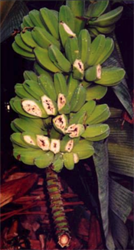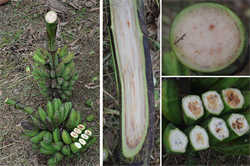Bugtok disease of banana.
Pacific Pests, Pathogens, Weeds & Pesticides - Online edition
Pacific Pests, Pathogens, Weeds & Pesticides
Banana bugtok disease (524)
Ralstonia solanacearum race 2, biovar 1; previously, it was known as Pseudomonas solanacearum, Burkholderia solanacearum. It is the same strain that causes moko disease in Asia, Africa, Central and South America, and more lately has been introduced into the Philippines (see Fact Sheet no. 525).
Bugtok and moko are names used to describe different symptoms of the same disease caused by the bacterium (Ralstonia solanacearum), but on different hosts: moko is used when the disease causes a yellowing of leaves and a wilt on Cavendish (AAA*) bananas grown on plantations worldwide, and bugtok describes rots in fruits of cooking bananas (ABB/BBB types) grown by smallholders for local markets in the Philippines. In a new classification system based on molecular analysis, Ralstonia solanacearum on banana is classified as Phylotype II (Indonesian) on origin and evolution. The abbreviation is BDB.
The Philippines. It was first described from southern Philippines, but now occurs in central and parts of the northern Philippines.
Banana, plantain, Heliconia, and several weeds, some without showing symptoms. The origin of the bacterium is thought to be the forests of Latin America and the Caribbean where it is endemic.
A disease of cooking bananas in the Philippines. When first described in the 1960s, the disease was of minor importance; since then it has increased to become a major problem. It occurs on varieties whose genetic make-up is mostly Musa balbisiana, (rather than Musa acuminata), and is especially common on the varieties Saba (BBB) and Cardaba (ABB).
Externally, plants appear healthy: leaves remain green and fruits seem normal; only the leaf-like bracts of the male inflorescence (flowers) show symptoms: they fail to fall, and the fruit stem becomes black, dry and distorted. Internally, there are brown streaks in the vascular tissues of the fruit stalk and in the leaf bases of the banana stem (or trunk). If fruits are present, some show brown or reddish discolouration in the fruit pulp (Photos 1&2), but they do not show premature ripening as they do with banana xanthomonas wilt (see Fact Sheet no. 523). The fruits may become hard when mature or when cooked.
The bacterium rarely becomes systemic in the plant, and plants do not wilt.
Spread is by insects visiting diseased and then healthy flowers, but there is little information on the ability of insects to carry the bacterium over long distances. It is thought unlikely to be spread in suckers as trials with naturally infected plants gave rise only to healthy plants. Also, there is no evidence that the bacterium spreads in water.
In recent years, bugtok has increased in importance and in many areas of the Philippines has resulted in crops of the popular varieties, Saba and Cardaba, being abandoned. Their loss impacts food and nutrition security - they are high in starch and an excellent source of vitamins A, B and C. They are not only an important part of local cuisine, being eaten raw or cooked as part of many Filipino dishes, but are also used in the manufacture of chips, flour and banana ketchup. They are sold as 'street food' in most towns and cities.
Look for Saba or Cardaba cooking bananas (in the Philippines) where the leaf-like bracts fail to fall from the blackened diseased male part of the fruit stem. Look for internal streaks (brown or reddish) in the fruit pulp and also for reddish-brown discolouration in the leaf sheaths of the stem.
Note that symptoms of bugtok, moko, blood disease and Fusarium wilt are similar (see Fact Sheets nos. 525, 522, 176), and there has been confusion between them.
- Moko and blood disease: leaves become yellow, droop and finally collapse, fruits show internal rots; discolouration of vascular system with ooze.
- Bugtok: infections are not (rarely) systemic and leaves do not wilt; male bacts fail to fall and blacken; internal fruit discolouration.
- Fusarium wilt (Panama disease): leaves become yellow and wilt; no fruit symptoms; discolouration of vascular system, but no ooze.
The bacterium causing bugtok of cooking bananas is identical to the bacterium that causes moko disease of Cavendish dessert banana in all cultural, morphological and biological characteristics, as well as being identical in PCR tests. It is known as the B strain of Ralstonia solanacearum in Honduras, and causes similar symptoms there and in the Philippines on Cavendish bananas, suggesting it was introduced as a single isolate from Central America. Laboratory tests are required to distinguish between moko/bugtok and blood disease.
BIOSECURITY
Countries where bananas are a staple crop and as yet free from bugtok should take all necessary precautions to prevent its further spread. Not only ABB/BBB cooking bananas are at risk, bugtok is caused by the same bacterium as moko, which infects Cavendish AAA bananas. At present, bugtok has been found in ABB/BBB bananas only in the Philippines. Where official transfers of banana, including its wild hosts, are required, these should follow the FAO/IBPGR Technical Guidelines for the Safe Movement of Germplasm. No. 15. Musa. 2nd Edition, (http://www.bioversityinternational.org/uploads/tx_news/Musa_spp.__2nd_edition__502.pdf). These state that germplasm should be transferred as virus-indexed plantlets growing in a sterile tissue culture medium.
CULTURAL CONTROL
If smallholders lack the resources to carry out all the recommendations below, they should focus on the three that are most important: (i) monitoring, and removal of disease plants (NOT the whole mat including healthy plants) as soon as they are seen, (ii) removal of the unopened male flower buds (called 'de-budding') usinf forked stick, and (iii) frequent wiping of tools with bleach to rid them of bacteria. Commercial plantations will do these routinely as part of production practices.
Before planting:
- Do not plant near plots that have the disease; above all, do not plant suckers down-wind from diseased plants, otherwise bacteria will be spread easily by insects from diseased to healthy plants.
During growth:
- Bag the young inflorescence as it emerges and bends down. Polyethylene, muslin or fine nylon bags can be used. Remove the bags after the fruits are set, if followed by removal of the male parts.
- Remove male buds (de-budding) immediately after the last hand emerges. Ideally, a forked stick is used to twist the male bud and remove it, rather than cutting it off with a machete that is potentially contaminated with bacteria. This is now standard practice when growing ABB/BBB bananas.
- Clean tools (especially knives used for de-suckering and removing diseased plants) and machinery by wiping with bleach (dilute one part household bleach with three parts water), clean soil from footwear, and prevent animals and vehicles moving through diseased areas to those that are healthy.
- Check (monitor) farms frequently for symptoms of bugtok on the male flowers parts. Remove diseased plants. Inject stems with herbicides or cut out plants at soil level, leaving the suckers to grow; this method relies on the failure of the bacterium to colonise the suckers systematically. Bury or when dry, burn the diseased plants on site, including infected fruits.
- Weed. Remove weeds that may be alternative hosts of the bacterium.
After harvest:
- Carry on monitoring and treating plants if symptoms are seen.
- If actions fail to control the disease, grow alternative crops, fallow the land, or plant a legume cover crop, such as Mucuna for 6-12 months.
RESISTENT VARIETIES
Cavendish (AAA) varieties are not seriously affected by bugtok under smallholder farmer conditions because insects are not attracted to them in the same way as they are to cooking bananas with their wide-opening bracts and male flowers with sweet nectar.
CHEMICAL CONTROL
Not a method to use for the control of this disease.
AUTHOR Grahame Jackson
Information from Blomme G, et al. (2017) Bacterial diseases of banana and enset: Current state of knowledge and integrated approaches toward sustainable management. Frontiers in Plant Science. (https://www.frontiersin.org/articles/10.3389/fpls.2017.01290/full#B66); and Liberato JR & Gasparotto L (2006) Moko disease of banana (Ralstonia solanacearum ). PaDIL - http://www.padil.gov.au; and from Soguilon CE (1995) Musa disease fact sheet no. 6. Bugtok disease of banana. International Network for the Improvement of Banana and Plantain, Parc Scientifique Agropolis, 34397 Montpellier, Cedex 5, FRANCE. Photo 1 Unknown (2006) Bacterial wilt of banana diagnostics manual. Plant Health Australia and Cooperative Research Centre for Tropical Plant Protection. (https://www.planthealthaustralia.com.au/wp-content/uploads/2013/03/Banana-bacterial-wilt-or-Moko-DP-2006.pdf). Photo 2 Kind permission Guy Blomme, Bioversirty Internatinal, Addis Ababa, Ethiopia. From: Blomme G, et al (2017) (ibid).
Produced with support from the Australian Centre for International Agricultural Research under project HORT/2016/185: Responding to emerging pest and disease threats to horticulture in the Pacific islands, implemented by the University of Queensland, in association with the Pacific Community.
*The codes ABB and BBB are the amount of Musa acuninata and Musa bulbisiana (parents of many banana varieties grown) represented in each banana variety. An internationally recognised scoring system is used to determine the proportion.





